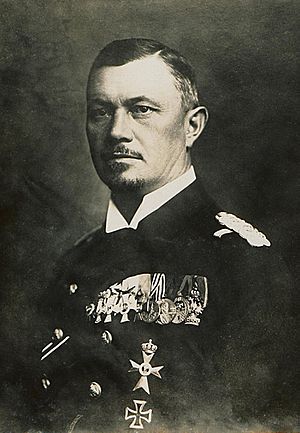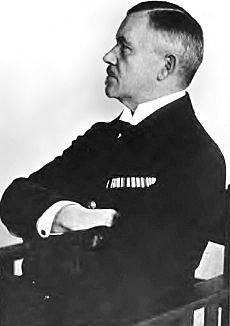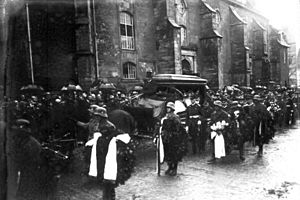Reinhard Scheer facts for kids
Quick facts for kids
Reinhard Scheer
|
|
|---|---|

Reinhard Scheer
|
|
| Born | 30 September 1863 Obernkirchen, Electorate of Hesse |
| Died | 26 November 1928 (aged 65) Marktredwitz, Weimar Republic |
| Allegiance | |
| Service/ |
|
| Years of service | 1879–1918 |
| Rank | Admiral |
| Commands held | SMS Gazelle SMS Elsass II Battle Squadron III Battle Squadron High Seas Fleet Chief of Naval Staff |
| Battles/wars | |
| Awards | See below |
Reinhard Scheer (born September 30, 1863 – died November 26, 1928) was a German Admiral. He served in the Imperial German Navy during World War I. Scheer joined the navy in 1879 as a young cadet. He worked his way up, commanding many ships. He also held important jobs on land.
When World War I started, Scheer led the II Battle Squadron. Later, he took command of the III Battle Squadron. This group had the newest and strongest battleships. In January 1916, he became an Admiral. He then took charge of the entire High Seas Fleet. Scheer led the German fleet at the Battle of Jutland in May and June 1916. This was one of the biggest naval battles in history.
After the battle, Scheer wanted to use unrestricted submarine warfare against the Allies. The German Emperor, Kaiser Wilhelm II, eventually agreed. In August 1918, Scheer became the Chief of Naval Staff. Admiral Franz von Hipper took over the fleet. They planned one last big battle against the British fleet. But sailors were tired of the war and refused to fight. This event was called the Wilhelmshaven mutiny. The plan was stopped. Scheer retired after the war ended.
Scheer was known as a strict leader. Sailors called him the "man with the iron mask" because he looked very serious. He wrote his life story in 1925. Scheer died in Marktredwitz. He is buried in Weimar. A German warship, the heavy cruiser Admiral Scheer, was named after him in the 1930s.
Contents
Scheer was born in Obernkirchen, Germany. His family was not rich. This made it harder for him to rise in the navy at first. The navy was mostly led by wealthy families.
Reinhard Scheer joined the navy on April 22, 1879, when he was 15. His first ship was the sailing frigate SMS Niobe. He learned about navigation and engineering on this ship. After returning to Germany, he went to the Naval School in Kiel. He did well in his exams there. Then, he had special training in gunnery and torpedo warfare. He served on several ships, including the frigate SMS Hertha. This ship sailed around the world. It visited places like Australia, Japan, and China.
After becoming an officer, he went to the German East Africa Squadron. He served there from 1884 to 1886 on the frigate SMS Bismarck. He was promoted to Leutnant. He also met important people, like Leutnant Henning von Holtzendorff. Holtzendorff later became commander of the High Seas Fleet. In Africa, Scheer helped stop a local leader who was causing trouble.
In 1886, Scheer returned to Germany. He trained in torpedo warfare. In 1888, he went back to the East Africa Squadron. He was a torpedo officer on the ship SMS Sophie. He returned to Germany in 1890. He became an instructor at the Torpedo Research Command in Kiel. Scheer became known as a very good torpedo expert. While in Kiel, he met Alfred von Tirpitz. Tirpitz noticed Scheer's skills. In 1897, Tirpitz moved Scheer to work in the Torpedo Section of the navy office.
Scheer was promoted to Korvettenkapitän. He commanded the light cruiser SMS Gazelle. In 1905, he became Kapitän zur See. He took command of the battleship SMS Elsass in 1907 for two years. In 1909, he became chief of staff for Admiral Holtzendorff. Scheer became an Admiral himself when he was 47. He stayed in this role until 1911. Then, he worked for Tirpitz again. In 1913, Scheer returned to sea. He commanded the six battleships of the II Battle Squadron.
On December 9, 1913, Scheer was promoted to Vizeadmiral. He stayed with the II Battle Squadron until January 1915. By then, World War I had started. He then took command of the III Battle Squadron. This squadron had the strongest battleships in the German fleet. These were the dreadnoughts of the Kaiser and König class classes. Scheer believed in attacking the British coast. This would make parts of the British navy come out. Then, the German fleet could defeat them. He thought Admiral Friedrich von Ingenohl was too careful.
After the bombardment of Scarborough, Ingenohl pulled back instead of fighting a weaker British group. Scheer said Ingenohl "robbed us of the opportunity." After Germany lost SMS Blücher at the Battle of Dogger Bank in January 1915, the Kaiser removed Ingenohl. Admiral Hugo von Pohl took his place. Pohl was very cautious. For the rest of 1915, he only did five small fleet actions. All of them stayed close to Helgoland.
Leading the High Seas Fleet
Vice Admiral Scheer became the Commander in Chief of the High Seas Fleet on January 18, 1916. Pohl was too sick to continue. When Scheer got the job, he wrote his plans for sea warfare. He wanted to put pressure on the British fleet. He planned more U-boat attacks and air raids. He also wanted to send the fleet out more often. He hoped this would force the British fleet to attack the Germans. The Kaiser approved Scheer's plan in February 1916. Now, Scheer could use the fleet more aggressively.
The Kaiser ordered to stop unrestricted submarine warfare in April 1916. Scheer then ordered all U-boats in the Atlantic to return to Germany. He wanted to use the submarines to help the fleet. He planned to place them near major British naval bases. The U-boats would attack British ships leaving port. This would happen after German battlecruisers attacked British towns. Scheer planned this for May 17. But a ship, SMS Seydlitz, was damaged. Also, some battleships had engine problems. So, the plan was delayed until May 31.
The Battle of Jutland
Admiral Scheer's fleet left the Jade early on May 31. It had 16 large battleships, six older battleships, six light cruisers, and 31 torpedo boats. They sailed with five battlecruisers led by Hipper. The British navy had found out about the German plan. They sent their Grand Fleet out the night before. This fleet had 28 large battleships and 9 battlecruisers. They wanted to trap and destroy the German fleet.
At 4:00 PM, the two groups of battlecruisers met. They started fighting as they sailed south towards Scheer's main fleet. When they reached Scheer's fleet, British battlecruisers turned north. They wanted to trick the Germans into following them. The British Grand Fleet, led by Admiral John Jellicoe, was coming fast. As the Germans sailed north, Scheer's ships fought some British battleships. By 6:30 PM, the Grand Fleet arrived. They were in a position to "cross Scheer's T" from the northeast. This meant the British ships could fire all their guns, while the German ships could only fire their front guns.
To get his fleet out of this dangerous spot, Scheer ordered a sharp turn to the southwest. This move put Scheer in danger again. Jellicoe turned his fleet south and again "crossed Scheer's T." Scheer ordered another sharp turn. Hipper's damaged battlecruisers covered this turn. Scheer then ordered the fleet to get ready for night sailing. This was done by 11:40 PM. There were fierce fights between Scheer's battleships and British destroyers. But the Germans managed to get through. They headed for Horns Reef. The German fleet reached their home port between 1:00 PM and 2:45 PM on June 1. Scheer ordered the undamaged battleships to guard the port.
After Jutland
After the battle, Scheer wrote a report for the Kaiser. In it, he strongly pushed for starting unrestricted submarine warfare again. He said it was the only way to defeat Great Britain. Scheer spent most of the rest of the year arguing about this with naval leaders. Finally, Scheer and his supporters won. Unrestricted submarine warfare started again in February 1917.
Even though he believed U-boats were key, Scheer kept using the surface fleet. On August 18–19, 1916, the High Seas Fleet sailed out again. They tried to draw out and defeat Admiral Beatty's battlecruisers. The British navy again found out about the German plan. They sent out the Grand Fleet. But this time, Scheer's scouts warned him in time. He was able to retreat back to Germany.
In late 1917, Scheer started using smaller parts of the fleet to attack British convoys going to Norway. This made the British send battleships to protect the convoys. This gave Scheer a chance to try and trap some British battleships. On April 23, 1918, Scheer sent the entire High Seas Fleet to attack a convoy. But Hipper's battlecruisers missed the convoy several times. German spies had made a mistake about when the convoy would leave Britain. The German fleet turned south and reached their bases by 7:00 PM.
In June 1918, Scheer learned that Admiral Holtzendorff was too sick to continue as chief of the naval staff. On July 28, Scheer was told that Holtzendorff had resigned. Two weeks later, on August 11, 1918, Scheer was promoted to Chief of Naval Staff. His second-in-command, Franz von Hipper, took over the High Seas Fleet. The next day, Scheer met with Field Marshal Paul von Hindenburg and General Erich Ludendorff. They talked about how badly the war was going. They all agreed that U-boats were Germany's only hope for victory. The German army was now on the defensive.
Scheer then called for a quick plan to build many more U-boats. He wanted at least 16 new U-boats built each month in late 1918. This number would increase to at least 30 per month by late 1919. In total, he wanted 376 to 450 new U-boats. However, some historians believe this plan was mostly to make people at home and abroad think Germany was still strong.
In October, the war was mostly lost. Scheer and Hipper planned one last big fleet attack. They wanted to damage the British navy as much as possible. This would give Germany a better position in peace talks. The plan involved two attacks by light cruisers and destroyers. One would be on Flanders, and the other on ships in the Thames estuary. The five battlecruisers would support the Thames attack. The main battleships would stay near Flanders. After both attacks, the fleet would meet off the Dutch coast. There, they would fight the Grand Fleet.
But as the fleet gathered in Wilhelmshaven, many sailors started leaving. On October 24, 1918, the order was given to sail. But starting on the night of October 29, sailors on several battleships refused to obey orders. This was the Wilhelmshaven mutiny. Some ships refused to leave the harbor. There were also acts of sabotage on ships like Thüringen and Helgoland. Because of this open rebellion, the order to sail was canceled. The planned operation was stopped. To try and end the mutiny, the High Seas Fleet was broken up.
After the War
Scheer wrote his memories of World War I in 1919. They were translated into English the next year. In October 1920, a person broke into Scheer's house. His wife, Emillie, and his maid were killed. His daughter Else was hurt. After this sad event, Scheer lived a quiet life. He wrote his autobiography, called Vom Segelschiff zum U-Boot (From Sailing Ship to Submarine). It was published on November 6, 1925.
In 1928, Scheer was invited to meet his old enemy from Jutland, Admiral of the Fleet Jellicoe, in England. However, Scheer died at the age of 65 in Marktredwitz before he could make the trip. He was buried in the cemetery in Weimar. His tombstone says: hier ruht admiral reinhard scheer [Here rests Admiral Reinhard Scheer]. It also shows his life dates, his flag, and the word skagerrak. Skagerrak is the German name for the Battle of Jutland.
The heavy cruiser Admiral Scheer was named after Reinhard Scheer. His daughter Marianne christened the ship. The ship was built in the 1930s.
Images for kids
See also
 In Spanish: Reinhard Scheer para niños
In Spanish: Reinhard Scheer para niños





